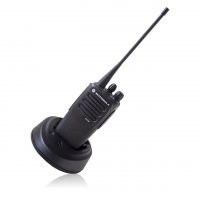The idea of being able to talk to your friends without having to pick up the phone is exciting for many kids. Walkie-talkies are a great way for children to stay connected, but there are some safety tips that parents should consider before handing them out. Let’s take a look at what you need to know about kids using walkie-talkies.
Table of Contents
What Is a Walkie-Talkie?
A walkie-talkie, an ingenious invention dating back to the 1940s, is a small, portable communication device that has stood the test of time. Operating through radio frequencies, it enables people, even in remote areas, to engage in conversation without a cellular reception. Walkie-talkies have earned their place in the realm of essential gear for adventure-seekers, rescue teams, and event organisers, to name just a few.
Known for their simplicity in use and compact design, walkie-talkies are a reliable way to stay connected across varying distances. When one thinks of exploration, huddling around a walkie-talkie, eagerly waiting for a transmission from a distant friend or fellow explorer springs to mind: it’s the walkie-talkie that represents the thrill of being at the forefront of untamed territory.
What is The Appropriate Age To Use Walkie-Talkies?
Walkie-talkies have long been a staple in various communicative scenarios, from outdoor adventures to professional use in industries, and even as a source of entertainment for children playing outdoors.
A common question that often arises is, what is the appropriate age to use walkie-talkies? Are they simply meant for adults, or can children get in on the fun? In reality, walkie-talkies are versatile gadgets that cater to a wide range of age groups. With child-friendly models designed specifically keeping in mind their ease of use and limited range for safety, kids as young as five years of age can enjoy utilising walkie-talkies to interact with their playmates or parents.
Meanwhile, adults can enjoy more advanced models with extended ranges and additional functions, making them essential tools for professional endeavours, outdoor activities, and emergency situations. Ultimately, the appropriate age for using walkie-talkies largely depends on selecting a model that best suits the user’s age, capabilities, and purpose.
Safety Considerations When Letting Kids Use Walkie Talkies
Walkie-talkies can be an enjoyable, practical, and educational tool for children to use, either for play or as a means of convenient communication. However, it is essential for parents and guardians to take safety considerations into account when allowing kids to use these devices.
One of the critical factors to consider is the range of the walkie-talkies, as this ensures that children remain within a safe, predetermined area while using them. Parents should also teach children how to use the device in a responsible way, such as developing a shared channel specifically for their family and insisting on the use of appropriate language.
Additionally, monitoring the device’s battery use helps avoid any unexpected communication loss, ensuring a smooth experience for both children and parents. With these safety considerations in place, walkie-talkies can become a valuable tool for fostering independence and communication skills in children, enriching their lives with a fun and engaging activity.
The Pros of Walkie-Talkies for Kids
Walkie-Talkies Can Encourage Imagination
Walkie-talkies have a remarkable knack for sparking creativity and fostering imaginative play among children. By providing a unique, long-range communication platform, these two-way radios transport kids into thrilling realms of secret agents, police officers, or explorers deftly traversing uncharted territories.
The simple act of whispering covert messages through walkie-talkies cultivates an exhilarating, shared experience that builds camaraderie and strengthens interpersonal skills. Furthermore, role-playing adventures help expand children’s cognitive abilities, contributing to the development of rich, symbolism-filled narratives in their formative years.
In today’s fast-paced, technology-driven world, it’s delightful to witness the enduring magic of walkie-talkies in igniting young minds and transforming mundane afternoons into captivating quests that bridge space and time.
Walkie-Talkies Can Help Kids Develop Social Skills
Walkie-talkies aren’t just for fun-filled adventures, they can also play a crucial role in helping children develop their social skills. These compact communication devices encourage kids to step out of their comfort zones and engage in meaningful conversations with their peers. By mastering the art of taking turns to speak, children learn to listen attentively and effectively respond to others.
Moreover, walkie-talkies open the door to developing teamwork and problem-solving skills by requiring kids to collaboratively accomplish tasks or work through challenging scenarios. In the age of digital communication, providing our children with walkie-talkies presents a unique opportunity to strengthen their essential social skills while keeping the excitement alive during playtime.
Walkie-Talkies Can Be Used in a Variety of Settings
Walkie-talkies can undoubtedly bring a sense of adventure and excitement to kids, providing them with endless opportunities for creativity and fun in various settings. These handy communication devices not only enhance their imaginative play at home, transforming them into secret agents or superheroes, but they are also invaluable when it comes to outdoor activities like hiking, camping, or playing in the neighbourhood.
Furthermore, walkie-talkies can serve as critical tools for parents to communicate with their children during school trips, ensuring that they stay safe and enjoy their experiences without the need for a smartphone.
With their simple push-to-talk operation and robust construction, walkie-talkies are both user-friendly and durable enough to withstand the playful energy of kids, making them an ideal communication companion in enhancing their ever-growing learning experiences.
The Cons of Walkie-Talkies for Kids
Lack of Privacy
In today’s world, where safeguarding children’s privacy is of utmost importance. The lack of privacy offered by walkie-talkies for kids raises valid concerns. Eavesdropping on conversations is almost effortless when using walkie-talkies. Anyone with a similar device within range can easily intercept the frequency and monitor the exchange of messages between kids.
This risk amplifies with the increase in stranger danger in public spaces, making it essential to educate children about taking precautions while communicating. Furthermore, the inability to delete or restrict access to previous conversations could lead to potential misuse and consequences that affect the child’s safety and personal space.
Thus, while walkie-talkies may add an element of fun and excitement in child play, the costs in terms of privacy should be carefully considered by parents and guardians.
Limited Range
While walkie-talkies provide kids with an exciting and interactive way to communicate with their friends and family, one of the downsides to these devices is their limited range. Children may get carried away by the thrill of exploring or playing around their neighbourhood, only to find out that they have ventured beyond the range of their walkie-talkies.
This can lead to instances of frustration or even worry, as parents may not be able to keep track of their children’s whereabouts or communicate effectively with them. Consequently, it is essential for parents to educate kids about the importance of staying within range and discussing alternative communication methods in case they find themselves in such situations.
By doing so, families can still enjoy the benefits of walkie-talkies while minimising potential drawbacks.
Interference
Interference stands out as a notable drawback when considering the use of walkie-talkies for children. While these gadgets can undeniably provide countless hours of fun and an accessible means of communication between youngsters, interference issues can often interrupt smooth conversations or play sessions.
This may occur when multiple users exist in proximity or when external factors, such as electronic devices or nearby radio stations, complicate transmissions. As a result, kids might experience moments of frustration or disappointment when their walkie-talkie connections falter or fail entirely.
Consequently, parents must weigh the benefits and drawbacks, taking into account the potential for interference, to determine if walkie-talkies are the most suitable communication tool for their little ones.
Requires Batteries
Another drawback to consider before letting children use walkie-talkie devices is their dependence on batteries. This can impact not only your budget but the environment as well. Frequent battery replacements can lead to a buildup of waste, as many batteries are composed of harmful chemicals.
Additionally, the inevitable burst of creativity and adventure that comes from using a walkie-talkie can be cut short by an unexpected outage due to drained batteries. As a result, it may be crucial to prepare a sustainable alternative, such as rechargeable batteries, to ensure uninterrupted communication and playtime.
How To Select The Best Walkie-Talkies for Kids

Consider the Age of the Child
When selecting a walkie-talkie for a child, it is important to consider the age of the child. There are walkie-talkies designed for children as young as three years old, and there are also walkie-talkies that are more suitable for older children. It is important to select a walkie-talkie that is appropriate for the age of the child, as younger children may be unable to use a more sophisticated walkie-talkie.
Choose a Walkie-Talkie with Simple Controls
Another important consideration when selecting a walkie-talkie for a child is to choose one with simple controls. Children can get easily frustrated if they are unable to figure out how to use the walkie-talkie, so it is important to select one that has easy-to-use controls. Many walkie-talkies designed for children have large buttons and clear instructions on how to use the device.
Consider the Range
When selecting a walkie-talkie for a child, it is also important to consider the range. Walkie-talkies typically have a range of up to two miles, but some models have a greater range. If the child will be using the walkie-talkie outdoors, it is important to select one with a good range so that they can communicate with their friends even if they are far apart.
Choose a Walkie-Talkie with Good Battery Life
Children can get enthusiastic about using their walkie-talkies, and they may not realise how quickly the battery can be depleted. It is important to choose a walkie-talkie that has good battery life so that the child can use it for extended periods of time without having to recharge it frequently.
Select a Walkie-Talkie with Fun Features
Many walkie-talkies designed for children come with fun features that can make using the device more enjoyable for the child. Some walkie-talkies have built-in games or other fun features that can keep children entertained while they are using the device. These fun features can help make using the walkie-talkie fun for children and can also help them learn how to use it properly.
Are Go Com Walkie Talkies Worth It?
When considering communication methods for outdoor activities or group engagements, one might wonder if Go Com walkie-talkies are worth the investment. Understanding the advantages and potential limitations of these devices can aid in making an informed decision.
Go Com walkie-talkies offer reliable communication as one of the best work walkie-talkies in areas where cell phone signals may be weak or nonexistent, which is particularly valuable for hikers, backpackers, or even event organisers. These portable devices allow users to keep in touch with their group, boosting safety and coordination.
Additionally, they are user-friendly and usually more cost-effective than constantly relying on a cell phone in remote locations. However, the range of these walkie-talkies may be limited depending on the model, and their reliance on battery power can be a drawback.
Ultimately, the value of Go Com walkie-talkies depends on the specific needs and preferences of users. Still, they have proven to be a dependable and efficient communication tool in a variety of situations.
What is Wishouse Walkie-Talkie Range?
Wishouse walkie-talkies are revolutionising the way people communicate over long distances during their outdoor adventures. These impressive gadgets provide not only crystal clear audio but also maintain a remarkable signal range, allowing users to stay effortlessly connected, whether they are navigating dense forests or exploring mountain terrains.
Furthermore, Wishouse walkie-talkies are designed to be user-friendly and suitable for all ages, making them an excellent choice for family outings or team-building exercises. With features like adjustable volume control, LCD display, and durable construction, you can say goodbye to missed or misunderstood messages as you experience seamless, uninterrupted communication with your loved ones or teammates.
So, gear up for your next adventure and explore the great outdoors with confidence, knowing that Wishouse walkie-talkies have got your back.
Conclusion
Walkie-talkies can provide children with an easy way to stay in touch with their friends while still maintaining their independence and freedom. However, it’s important that parents understand the safety implications associated with using these devices so that they can ensure their child is using them responsibly and safely.
By taking the time to educate your child on these issues before handing them out, you can help ensure that everyone has a good experience when using walkie-talkies! You can check our website for additional walkie-talkie resources.





